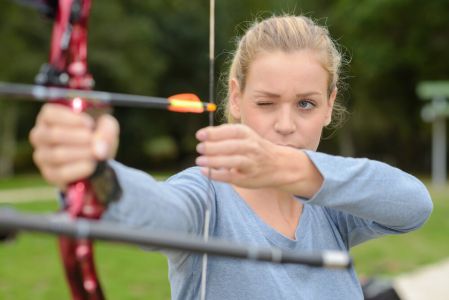Archery is a noble sport, one requiring patience and good aim. As is the case with most sports that involve the use of your hands, you might find that your performance will be elevated with the use of left or right-handed archery equipment. Left-hand recurve bows, compound bows and longbows have slight design differences from the right-handed version. Many competitive shooters are asked, “Should I buy a left or right handed bow?” Your dominant hand and your dominant eye are the factors that will determine whether you should get a left-handed or right-handed bow for archery. Your dominant eye is important because you will aim with your non-dominant eye closed, which could lead to sighting difficulties if you use the wrong bow.
In this guide, we will show you how to choose whether the compound or recurve bow you use should be left- or right-handed.
Table of Contents
- 1 How to Determine Bow Hand Orientation
- 2 How to Tell Which Eye is Dominant
- 3 Should You Get a Right Hand or Left Hand Bow?
- 4 How to Tell the Difference Between a Right Hand Vs Left Hand Bow
- 5 Can You Shoot a Right Handed Bow Left Handed?
- 6 Can a Left Eye Dominant Person Shoot a Right Handed Bow?
- 7 Are There Ambidextrous Bows?
How to Determine Bow Hand Orientation
Consider the bow stance. Your feet must be parallel to the shooting line, and while shooting, your back and bow arm should be straight, as should your shoulders. If you shoot left-handed, your left-hand draws, and you hold the bow in your right hand. Similarly, if you’re right-handed, you would draw with your right hand and hold the bow in your left hand. Consequently, you will be aiming out of the eye corresponding to your draw hand, although with both eyes open, which eye you’re using may not be obvious.
However, it’s not that simple for some people. To determine what orientation bow to buy, you need to take two things into consideration, your dominant hand, and your ocular dominance or eye dominance. Read on to find out what eye dominance is and how to determine it.
How to Tell Which Eye is Dominant
About 70% of people have ocular, or eye dominance that matches their dominant hand. If you’re left-handed and your left eye is your dominant eye, you can simply buy a left-handed bow and you’ll be fine. However, if you don’t fall under that category, you have cross-dominance. Cross dominance implies that your dominant eye does not match your dominant hand.
The two most commonly used tests of ocular dominance or eye dominance are the Miles Test and the Porta Test.
For the Miles Test, extend your arms in front of you, hold your hands up in a V shape, and center an object about 10 feet away from you within the V. Once you have done so, focus on the object, close one eye. Open your eye and repeat the process with your other eye. Notice what happens to the object when you close each eye. When closing one eye, you might have noticed that the object vanished from view, while you could see the object just fine when the other eye was open. The eye out of which the object remained visible is your dominant eye.
The Porta test is extremely similar to the Miles Test, the only difference being that instead of holding your hands up in a V shape, you hold up your thumb in front of the object. When you close one eye, the object might become visible next to your thumb, or remain out of sight. The eye out of which the object remains concealed is your dominant eye.
The effect of your vision “shifting” is known as Parallax, and is a common optical illusion. You can experience the parallax effect in action when you look out of the window of a moving vehicle. Street lights and trees next to the road seem to fly by, but objects further away seem to move by slower, and very distant objects can look like they aren’t moving at all.
In some rare cases, you might find that the object remains concealed or visible depending on the test you did, regardless of which eye you opened. This means you might have central vision. If you have central vision, you can just buy a bow that matches your dominant hand.
If you are cross-dominant, that is, if your dominant hand and dominant eye don’t match, you can make a choice based on personal preference and your willingness to retrain either your hand or your eye dominance. However, keep in mind that as you get older, it becomes more difficult to retrain your fine motor skills, so for cross dominant archery, you might find it easier to use your dominant eye and use your non-dominant hand from the start.
To decide what is more comfortable in terms of archery hand orientation, visit a range and try shooting with both orientation bows provided there, and see if you prefer a left or right handed bow.

Right Handed But Left Eye Dominant in Archery
If you are right-handed, but are left eye dominant, you have two options: you should probably use a left-hand bow and use your left eye for aiming, or you can use a right-hand bow. If you choose the latter, then consider buying an eye-patch or covering your right eye with something while you shoot, to avoid using your non-dominant eye while aiming.
Left Handed But Right Eye Dominant in Archery
As a left handed person with right eye dominance, you are recommended to use a right-hand bow and use your right eye for aiming. If you want to use a left-hand bow, buy an eye patch or cover your left eye while shooting. This is so that you avoid accidentally using your non-dominant eye while aiming, which can seriously mess up your shot.
Should You Get a Right Hand or Left Hand Bow?
Ultimately, getting a right hand or left hand bow depends largely on your hand and eye dominance, and sometimes on your personal preference.
If you have left hand and eye dominance, get a left-hand bow. If you’re right-handed and have right eye dominance, buy a right-hand bow.
If you’re cross-dominant, we recommend getting a bow for your dominant eye. If you have right eye dominance, get a right hand bow, or a left hand draw bow if you have left eye dominance.
If you have central vision, take your pick, you’ll find that your choice won’t make much difference. You might even want to consider choosing an ambidextrous bow, especially if you are also ambidextrous. If you choose to go the left-handed route, we can recommend the best left-handed recurve bows for your budget.
How to Tell the Difference Between a Right Hand Vs Left Hand Bow
To know if a bow is left-handed or right-handed, look at the bow’s riser with the string oriented towards you. There are three parts of the bow you need to look for – the arrow rest, the stabilizer, and the bow sight pin. Most bows have a sight pin, the stabilizer may or may not be present, and the arrow rest is what the arrow rests on when you take aim. The bow will almost certainly have one.
If the rest, stabilizer and sight are on the left side of the bow riser, the bow is right-hand oriented. If they’re on the right, the bow is left-hand oriented. The main feature to look for is the arrow rest, since not all bows come with a sight and stabilizer. You will also notice that the bow sight has numbers on it which should be right side up. If a left handed bow sight is used on a right handed bow, the numbers will be upside down but it will work just fine.
Can You Shoot a Right Handed Bow Left Handed?
The short answer is, yes, you can shoot a right handed bow left handed. If you’re a lefty with right eye dominance, you’re recommended to use a right-hand bow and draw with your right hand. If you’re a left hander with left eye dominance, however, you should probably stick to left-hand bows, because you will find it difficult to aim with a right-hand bow and using your right hand to draw the bow string back might be uncomfortable.
Can a Left Eye Dominant Person Shoot a Right Handed Bow?
Yes, a left eye dominant person can shoot a right-hand bow, particularly if you’re right-handed, but archery coaches don’t suggest that you do this, because you’ll need to train your right eye to aim, which can take weeks. Besides this, you will have trouble lining up your sight pins with the target, and finding an anchor point will be difficult. As evidenced by this study from the Oxford Academic Press, you’ll find it difficult even if you wear an eye patch over your left eye.
Are There Ambidextrous Bows?
Traditional longbows and some recurve bows are usually ambidextrous; however, most modern bows and compound bows are either left handed or right handed.
There are a few recurve bows available on the market that are meant for ambidextrous archers. The most prominent feature of an ambidextrous bow is the riser, which is molded to be held interchangeably in the left or right hand. In addition, there are arrow rests on either side of the riser.
You can also find accessories for your bow that are ambidextrous, although most are rated for a particular side.
Sights are usually ambidextrous, since the mounting can just be turned to the side of the riser you want it to be on. Finger tabs, gloves, quivers are made for a specific hand.
Chest guards aren’t ambidextrous either, the reason being that they only protect the side of your chest that the string will brush against, which varies depending on which hand you use to draw the string back. If your left hand is your drawing hand, the string brushes against the right side of your chest, so you’ll need a left-handed chest guard.
Plungers, clickers and arm guards are not rated for a particular side.
We hope that this guide will give you all the information you need about eye dominance in archery and helps you decide whether or not you need a left handed, right handed, or ambidextrous bow.
